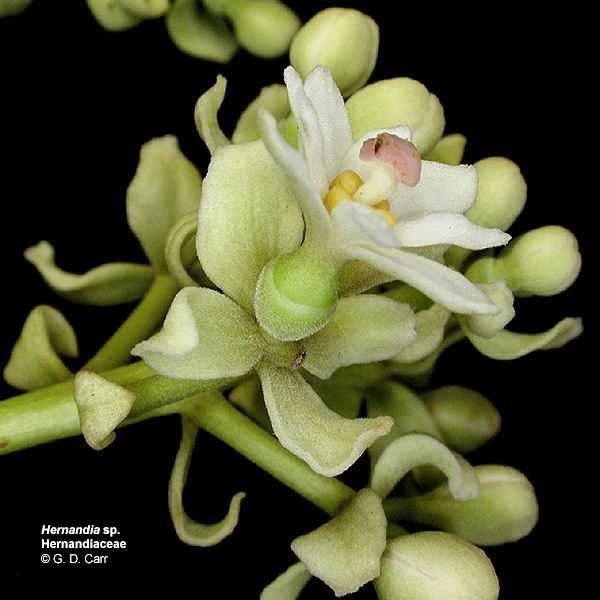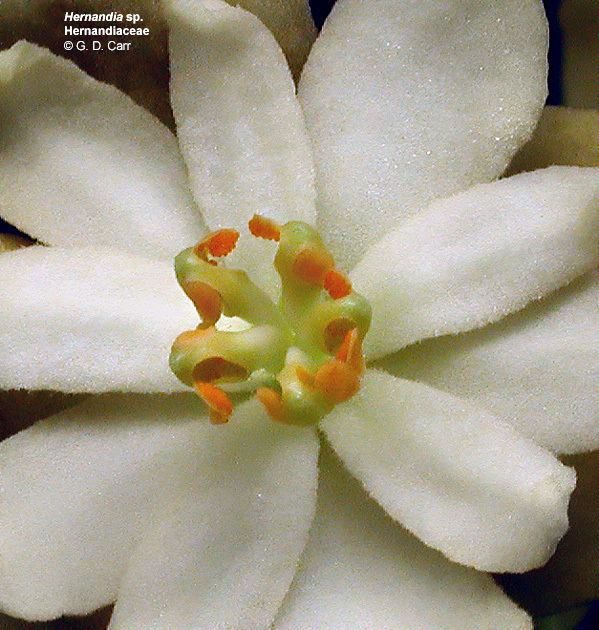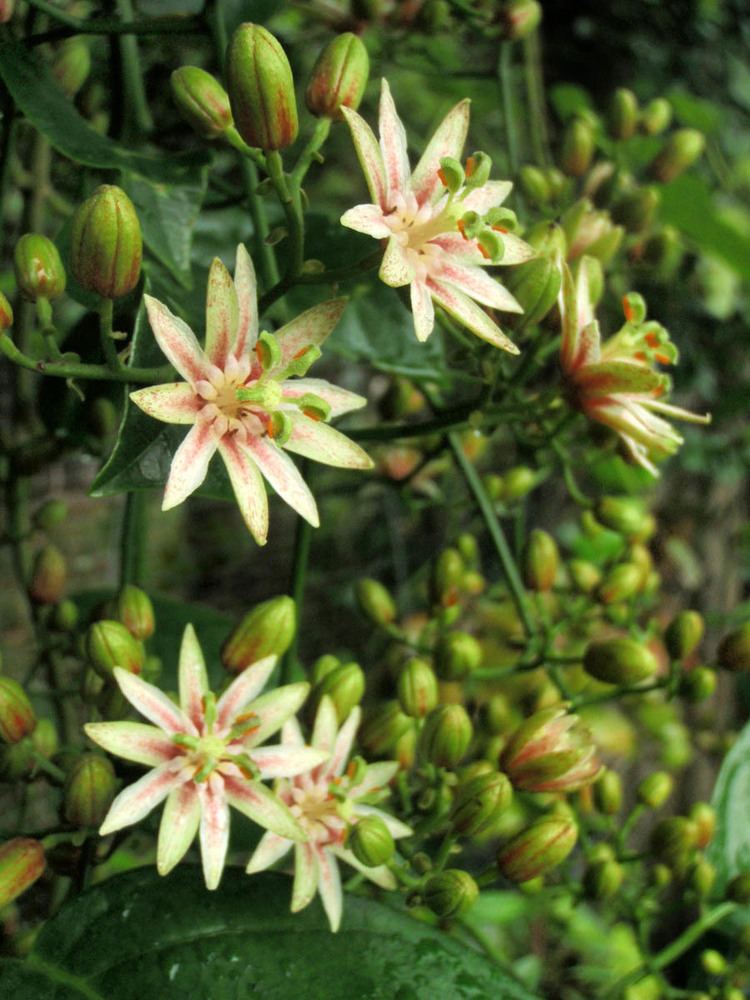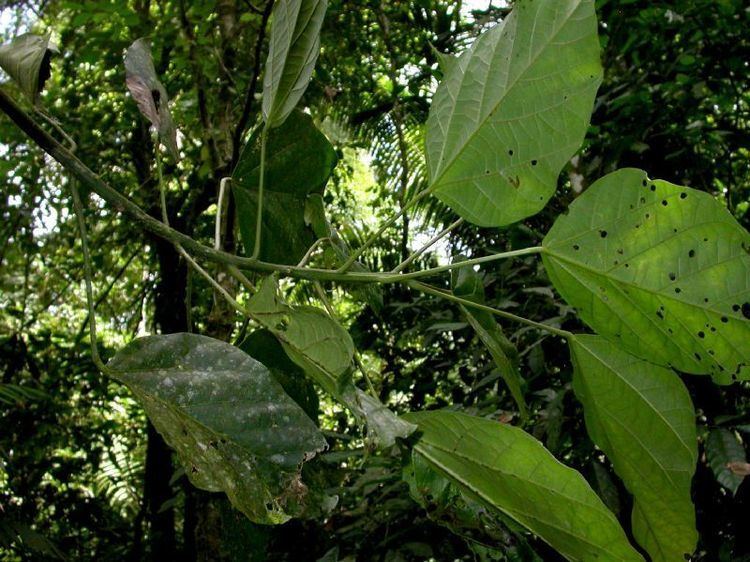Scientific name Hernandiaceae Rank Family | ||
 | ||
Lower classifications | ||
The Hernandiaceae are a family of flowering plants, angiosperms, in the order Laurales. Consisting of five genera with caabout 58 known species, they are distributed over the world's tropical areas, some of them widely distributed in coastal areas, but they occur from sea level to over 2000 m.
Contents

The family is closely related to the Lauraceae, and many species inhabit laurel forest habitat; they have laurel-like (lauroid) leaves. Based on morphology, chromosome numbers, geographical distribution, and phylogenetic analyses, the family is clearly divided into two groups that have been given the rank of subfamilies Gyrocarpoideae and Hernandioideae.

Overview
The Hernandaceae are important components of tropical forests ranging from low-lying to montane forests.

Because of the special lack of worldwide knowledge about the family in general, little is known about their diversity yet. The knowledge of this family to national level, is that to be expected in countries with limited economic means with the vast majority of species indeterminate or even poorly determined. Recently described new species come from collections made in countries with limited economic means. Therefore, an increase in the study of family, at national level, is of utmost importance for the progress of the systematics of the family in general. Trees of the Hernandiaceae family predominate in the world's laurel forests and cloud forests, which occur in tropical, subtropical, and mild temperate regions of the Northern and Southern Hemispheres, highlighting the African, Indian, and Pacific Ocean islands, New Caledonia, Madagascar, and central Chile.

The main economical uses for this family are essential oils, found in many species that are important for spices and perfumes, and the hardwood of many species is a source for timber around the world. A great number of species is in danger of extinction due to overexploitation as medicinal plants or timber extraction and loss of habitat.
Ecology

The Hernandiaceae are a very important family; their species inhabit the ecosystems with monoecious, rarely dioecious, deciduous or evergreen trees, shrubs, and perennial climbing plants. The mode of dispersion is variable among the species. Most species of genus Hernandia have red domes, suggesting zoochory, while Hernandia guianensis is hydrochorian in fresh water, and H. nymphaeifolia and Gyrocarpus americanus are hydrochorian in sea water.

The fruits are eaten by birds, passing through their digestive tracts, or are regurgitated; seeds germinate easily after. Zoocorian seeds are mostly in small fruits, desired by birds, containing many times a sticky substance coating the seed. Expelled, the seed sticks to the branch of trees and even dead bodies, or just in soil, germinating later.

Some fruits open very violently, expelling the seeds away. Others are small nuts or nonfleshy bodies (achenes) provided with hooks or filaments that stick to the fur of animals or are shaped to float in water or facilitate transport by wind.
They are distributed in the lower areas of the tropics, especially in rain forests, cloud forests, and laurel forest, although some species exist even in subtropical or arid areas; they occur from sea level to over 2000 m. Distributions in Africa and the Americas, for example, from Gyrocarpus hababensis and G. americanus, relict character, appear to be due to marine transgressions in the past.
The family originated in the coastal laurel forests of Gondwana, which is the reason for its pattern of distribution. The Hernandaceae inhabit montane tropical forests, some species reaching 4000 m above sea level, but most species are more frequent in low-altitude rainforests. Some deciduous species have adapted to demanding conditions in semiarid climates, but then they tend to depend on favorable edaphic conditions, for example, perennial aquifers, periodic groundwater flows, or periodically flooded forests in sand containing hardly any nutrients.
Flowers and fruit
The plants can be hermaphrodite, or monoecious. The flowers are aggregated in inflorescences, in cymes, regular, cyclic or tetracyclic. They present a perianth with distinct calyx and corolla. The corolla is not fleshy. Androecial members are free of the perianth and free of one another, single-whorled. Androecium exclusively of fertile stamens, or including staminodes (these in the form of 1–2 nectariferous glands outside the stamens, cf. Lauraceae). Staminodes external to the fertile stamens (3–5); oppositisepalous (alternating with the inner perianth whorl). Anthers dehiscing by longitudinal valves. Anther wall of the ‘dicot’ type. Pollen grains nonaperturate; 2-celled. Gynoecium 1 carpelled. Carpels reduced in number relative to the perianth. The pistil 1 celled. Gynoecium monomerous; of one carpel; inferior. Carpel stylate; apically stigmatic; 1 ovuled. Placentation apical. Ovules pendulous; anatropous; bitegmic; crassinucellate. Endosperm formation cellular.
The fruit in some species is not fleshy and presents these characteristics: fruiting carpel indehiscent, winged or enclosed in an inflated envelope derived from connate bracteoles, with only one nonendospermic seed, two cotyledons (fleshy, oily, smooth, or ruminate). The embryo is straight.
Taxonomy
The family has been recognised by most taxonomists. The APG II system of 2003 also recognizes this family, and assigns it to the order Laurales in the clade magnoliids. As circumscribed by APG, the family includes those plants that sometimes have been treated as forming the family Gyrocarpaceae. The family is usually described as counting four genera, totalling several dozen species.
Uses
The bark, seeds, and young leaves are purgative. The root is chewed as a remedy against eating poisonous crabs and fishes. The juice of the bark and leaves has depilatory properties. The available information on the plant parts used by Samoan healers, their modes of preparation, and application have been listed in Table 1.
Among the chemical compounds isolated from the family Hernandiaceae, the alkaloid corytuberine is the oldest known compound. Later, its derivative O,O-Dimethylcorytuberine was reported from several Hernandia species, including H. nymphaeifolia. Actinodaphnine and hernandion, were the earliest chemical compounds reported from the family hernandiaceae respectively. .
Species
Genus Hernandia
Genus Illigera
Genus Hazomalania
